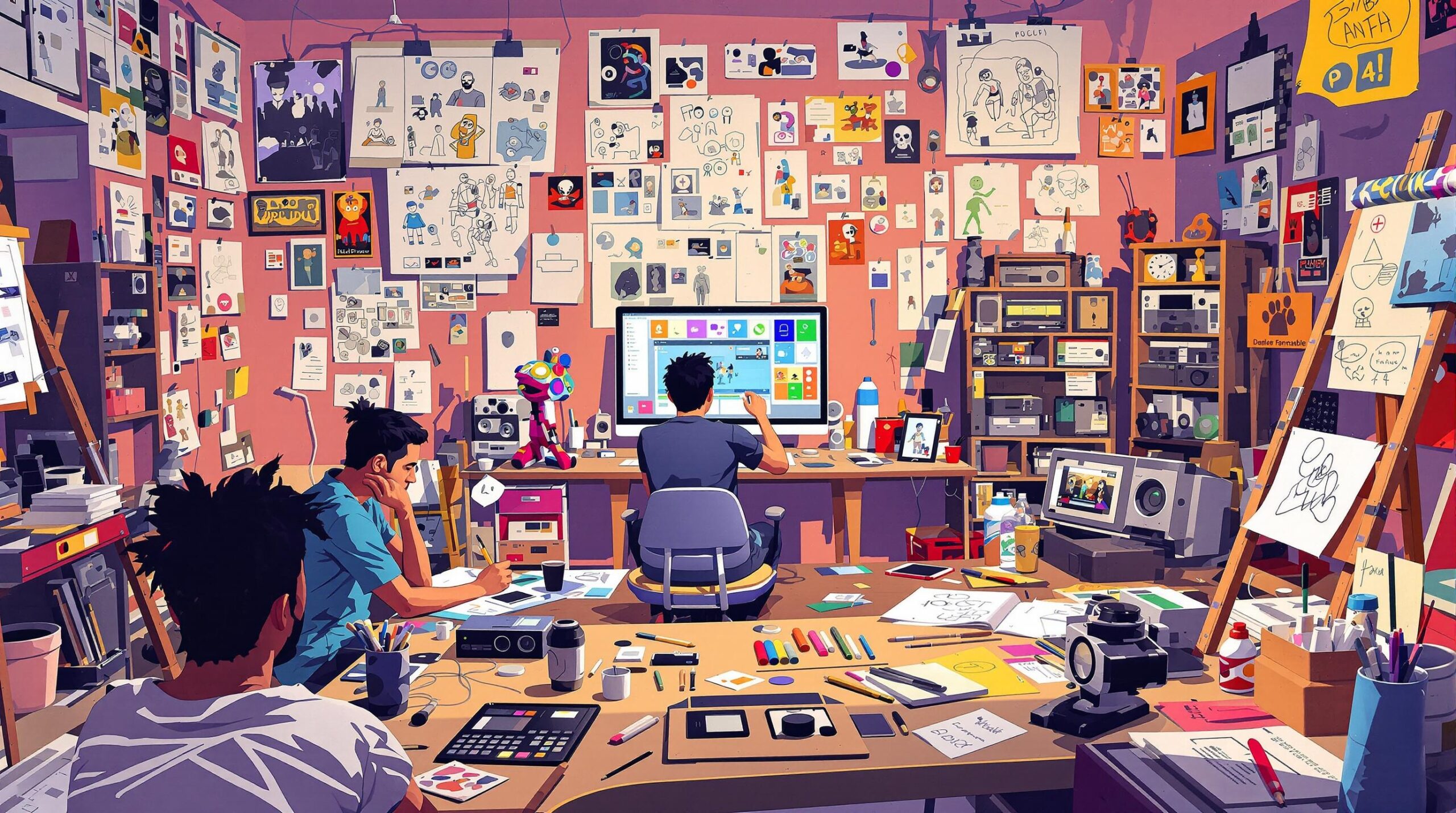Artificial intelligence (AI) has rapidly transformed various industries, including entertainment. Traditionally a labor-intensive process, animation is now significantly impacted by AI-powered tools. These innovative technologies reshape how creators develop animated content, offering new possibilities and efficiencies.
The Rise of AI in Animation
AI has moved beyond its initial niche applications and entered mainstream animation workflows. Studios now leverage AI to automate and enhance. These tools streamline tasks, improve quality, and expand creative potential. As a result, animators find more freedom to focus on storytelling and artistry.
Streamlining Animation Processes
Traditional animation involves complex stages, including storyboarding, keyframing, and in-betweening. AI tools automate some of these labor-intensive tasks, reducing time and effort. Software like Adobe’s Character Animator uses AI to perform real-time motion capture. This allows animators to map human movements directly onto digital characters. Consequently, production time decreases, and animations become more lifelike.
Rigging, another time-consuming step, also benefits from AI advancements. AI-driven rigging tools intelligently determine optimal bone structures and control systems. These innovations simplify the process of animating characters, enabling quicker turnaround times. Furthermore, AI aids in automating repetitive elements, such as background animations, saving animators countless hours.
Enhancing Visual Quality
Image enhancement and rendering improvements are other areas where AI makes significant contributions. Upscaling technology ensures animations maintain clarity and sharpness when converted into various formats. AI-powered tools like Nvidia’s DLSS employ machine learning algorithms to enhance rendering efficiency and quality. By utilizing fewer resources, studios achieve stunning visuals, maximizing computational power.
Moreover, AI algorithms analyze animation frames to detect inconsistencies and imperfections. These tools suggest corrections, leading to more refined and polished visual outputs. AI acts as an assistant, identifying issues and offering solutions, thus elevating overall animation quality.
Revolutionizing Character Animation
Characters lie at the heart of any animated narrative. AI tools offer remarkable advancements in this crucial aspect of animation. Deep learning models generate realistic facial expressions and emotions, bringing characters to life with unprecedented fidelity. Animators can effortlessly capture a wide array of emotions and intricacies.
Generative adversarial networks (GANs) have become instrumental in creating unique character designs. These networks generate realistic but novel character features, offering endless creative possibilities. Animation teams now develop diverse characters faster and more efficiently, enriching storytelling.
Sound and Voice in Animation
Synchronized sound and dialogue play a pivotal role in animated projects. AI technologies aid in voice synthesis, allowing realistic voice generation for characters. AI-driven voice synthesizers produce natural-sounding speech while maintaining emotional depth. Animators can create voiceovers without extensive recording sessions, reducing time and costs.
Lip-syncing, a crucial aspect of animation, benefits from AI advancements. AI models analyze audio tracks and match them with character lip movements. The result is seamless dialogue delivery, enhancing immersion and viewer experience. By automating this process, animators allocate more resources to other creative areas.
AI’s Role in Creativity and Storytelling
AI tools optimize technical processes and impact storytelling in animation. Storyboarding applications leverage AI to visualize scripts, offering dynamic previews of scenes. By automatically generating essential elements, such as camera angles and transitions, these tools bring stories to life.
Additionally, AI provides data-driven insights into audience preferences. By analyzing viewer behaviors, AI suggests narrative elements resonating with different demographics. This supports animation teams in tailoring content, ensuring it aligns with audience expectations and trends.
Machine learning models can even propose plot variations and character arcs. Animators use these suggestions as creative catalysts while maintaining narrative control. This collaborative synergy fosters innovative storytelling, allowing content creators to push traditional boundaries.
The Importance of Human Touch
Despite AI’s contributions, the human element remains integral in animation. AI is a powerful assistant, freeing animators up more nuanced tasks. Human ingenuity and creativity remain the driving forces behind compelling stories and characters.
AI lacks the emotional depth and intuition necessary to connect with audiences. Animators infuse their work with personal touches, emotional subtleties, and unique perspectives. Thus, a harmonious balance between AI and human input fosters richer and more engaging animations.
Collaborative Workflows in the Animation Industry
AI tools foster collaborative workflows, enhancing communication within animation teams. Teams can share AI-generated assets through cloud platforms, enabling real-time project collaboration. Artists work together seamlessly, transcending geographical barriers.
This collaborative atmosphere extends beyond individual studios. AI tools facilitate global partnerships, allowing animation studios to pool resources and expertise. Such collaborations lead to innovative projects, blending diverse cultural influences and talents.
Moreover, AI encourages cross-disciplinary collaboration. Coders, animators, and storytellers pool their skills to exploit AI’s potential in animation. This synergy drives technological advancement and narrative innovation, revolutionizing the industry.
Challenges and Ethical Considerations
AI’s growing role in animation brings challenges and ethical considerations. The animation industry must address concerns about job displacement as automation increases. Companies navigate balancing AI-driven efficiency with sustaining employment opportunities for animators.
Moreover, animation quality standards need to be re-evaluated in AI-integrated workflows. Ensuring AI-generated content aligns with traditional animation quality standards is critical. Studios must establish guidelines defining AI’s role, preserving craftsmanship quality and authenticity.
Ethical questions arise regarding AI’s influence on creative decision-making. While AI enhances creativity, it should not stifle individual artistic expression. Safeguarding diversity of thought and originality remains paramount in animation.
Looking to the Future
AI-powered tools hold the potential to evolve animation techniques in unprecedented ways further. Continued advancements will enhance automation, quality, and storytelling. As AI technologies mature, the animation industry embraces innovative workflows and narratives.
Training AI models on diverse data sets enhance accuracy and variation in character representation. Including underrepresented groups in AI training helps create authentic portrayals, enriching animated narratives. By prioritizing diversity, the animation industry mirrors societal complexities, creating inclusive worlds.
The pace of AI advancements necessitates ongoing learning and adaptation for animators. Animation professionals continuously update their skills to stay relevant in a rapidly evolving landscape. Upskilling initiatives and education programs empower animators to harness AI’s potential fully.
Conclusion: Harmonizing AI and Human Creativity
Ultimately, AI-powered tools represent a revolutionary shift in animation techniques. They streamline workflows, enhance visual quality, and open new creative avenues. Yet, the human touch remains essential in crafting stories that resonate deeply.
A collaboration between AI technologies and human creativity defines the future of animation. Embracing this partnership enables animators to create richer narratives, pushing the boundaries of imagination. The animation industry stands at the forefront of a technological revolution, led by innovative AI-powered tools.


